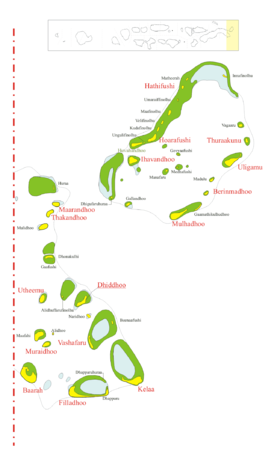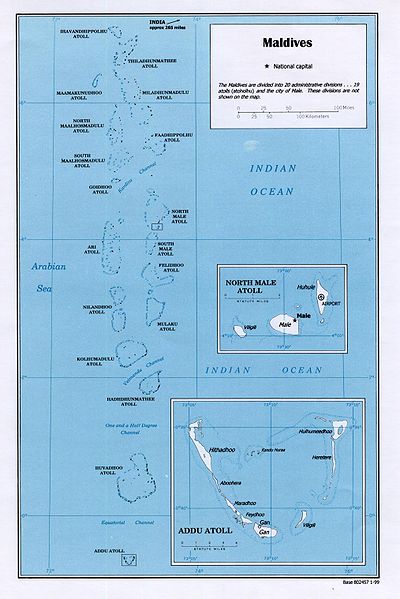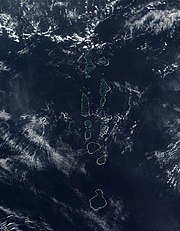<$

Constitution of the MaldivesThe first Constitution of the Maldives was proclaimed on December 2, 1932, under the rule of Sultan Muhammad Shamsuddeen III. He issued a decree on March 19, 1931, to compile a written Constitution.
In 1930 Bernard H. Bourdill, the then acting Governor of Ceylon, visited Malé to advise the Sultan and the government of the Maldives in drafting of the First Constitution. His visit was made at the request of the Maldivian Government.
The compiled Constitution contained 92 articles. It took exactly 1 year, 8 months and 22 days from the Sultan's decree to draft a Constitution to the ratification of the document.
President of the MaldivesThe President of the Maldives is the ceremonial head of state and first citizen of Maldives and the supreme commander of the Maldivian armed forces.
The current President of the Republic of Maldives is Maumoon Abdul Gayoom.
List of presidentsMohamed Amin Didi, 1953
Ibrahim Nasir, 1968 - 1978
Maumoon Abdul Gayoom, 1978 - Present
Maumoon Abdul Gayoom
Maumoon Abdul Gayoom (Dhivehi: މައުމޫނު އަބްދުލް ގައްޔޫމް) (born December 29, 1937), has been the president of the Republic of Maldives since November 11, 1978, having succeeded Ibrahim Nasir. He was last re-elected to a sixth five-year term in October 2003 with 90.28% of the vote. He was the sole candidate, having been chosen by the Majlis or Assembly. The election is carried out as a referendum and a yes or no vote is chosen by the public.
Early and personal life
Maumoon Abdul Gayoom is the son of Abdul Gayoom Ibrahim (Maafaiygey Dhon Seedhi) and Khadheeja Moosa. His father had 25 children by 8 different wives and Gayoom is the 10th in his family. His mother died when he was studying in Cairo, Egypt. Gayoom's father who died in 1982, at the age of 87, saw the first term of his son's presidency.
Much of Gayoom's early life was spent in Egypt. He was among the 15 students selected at the direction of the then-president Mohamed Amin Didi for special education overseas. At the age of 10, he left to Egypt on September 15, 1947 but was to stay in Ceylon for few days. However his departure from Ceylon to Egypt was delayed for two and a half years, because of the Arab- Israeli conflict started due to recognition of the Israel by the United Nations, at the end of the World War II. When the situation improved, with the end of war in middle-east, he left to Egypt in March 1950 along with other Maldivian students. He spent almost 24 years outside Maldives except for the brief period he once came to Maldives in 1964. After sometime in Maldives, again he left to Egypt to begin studying for Diploma of Education. He did complete his MA degree in 1966 but could not complete his PhD due to funding issues (See sub-section, Education). After completing his MA degree, he worked in American University in Cairo, in 1967, as research assistant in Muslim History under professor Mardsen-Jones. There he worked for almost 2 years and left to Kano, Nigeria.
In 1965 Gayoom met Nasreena Ibrahim, a student who had just arrived to Cairo from the Maldives for her studies. She was 15 then and Gayoom was 27. Four years later they married in Cairo, on July 14, 1969. Just few weeks after his marriage, he joined Ahmadu Bello University in Kano, Nigeria as lecturer in Islamic Studies and moved there with Nasreena. In March 20, 1970, at the age of 20, Nasreena gave birth to twins, Dhunya Maumoon and Yumna Maumoon. When Nasreena got pregnant for the second time it was arranged to send her to Malé. She gave birth to their first son, Farish, in Malé, on March 31, 1971. Nine years later, during Gayoom's presidency, Ghassan Abdul Gayoom was born on June 12, 1980.
During his time at Egypt he was particularly interested in Egyptian Political Affairs. He was closely following the revolutionary movement accelerated by the Muslim Brotherhood and Free Officers Movement of Gamal Abdel Nasser. He attended several public meetings of Muslim Brotherhood where celebrated orators like Sayyid Qutb railed against Britain, imperialism and King Farouk's Government. In July 1952 Gayoom was at Muslim Brotherhood camp, on holiday, when Gamal Abdel Nasser took over the power in a bloodless military coup. In his book A Man for All Islands, biographer Royston Ellis wrote, "Maumoon regarded it as a privilege to be able to hear Sayyed Qutb".
EducationMaumoon Abdul Gayoom acquired his education from Al-Azhar University of Egypt. He went to Egypt in March 1950 when he was 12. In Egypt he spent six months learning Arabic in order for his enrolment in the Faculty of Sharia and Civil Law.
In 1966, he obtained his Bachelor's degree and Master's degree in Islamic Sharia and civil Law, with the degree of excellence with honors. In addition to his MA from Al-Azhar University, he obtained a second Masters Degree in the same field from the American University in Cairo. Gayoom came out first in the Faculty of Islamic Law and Studies, at Al-Azhar University and was awarded his graduation certificate by Gamal Abdel Nasser.
Maldivian government decided to stop the grants for Maldivian students at Al-Azhar University for their attempted interference with then Prime Minister, later president, Ibrahim Nasir's decision to establish diplomatic ties with Israel. Fourteen Maldivian students on Gayoom's direction, including Gayoom himself, sent a signed letter to Ibrahim Nasir to reconsider the decision. Consequently their grants were stopped. The students were then financed by the Egyptian Government. By the time Gayoom acquired his MA degree, Egyptian government decided to stop the funding. As a result of being "black listed", by the government for his attempted intervention, Gayoom decided not to go back to Maldives. Financially he was prevented from completing his PhD. Later with his marriage he decided not to go further with his studying.
Career and politicsBefore returning to Maldives, after his studies, Gayoom worked in American University in Cairo in 1967 and Ahmadu Bello university in Kano, Nigeria as lecturer in Islamic Studies for two years from 1969. When his two year contract with Ahmadu Bello university ended, he decided to return to the Maldives. After almost 24 years since he first departed Maldives for studies, he returned to Maldives in 1971?. Three weeks after arrival he joined Aminiyya School as a teacher where he taught English, Arithmetic and Islam. In 1972 he was appointed as the manager of the Government shipping department.
On March 12, 1973, Gayoom was held under housearrest for criticising president Ibrahim Nasir's policies. In May 1973 he was tried in court and by the end of trial he was sentenced to banishment for four years, in May 14, 1973. A week after the sentence, on May 21, he was taken to Makunudhoo island of Haa Dhaalu Atoll. By the time he served 5 months of his punishment, Gayoom was released on October 13, 1973, by Ibrahim Nasir's amnesty following his re-election for another five-year term.
In 1974 Gayoom was appointed as under-secretary in the Telecommunications Department. After ten weeks he was promoted to Director of the department. During this period he worked as a part-time teacher in some private schools, teaching Islam, Arabic and English.
In July 28, 1974, Gayoom was again arrested for criticising Nasir's policies. This time he was kept in solitary confinement in a prison nicknamed "China garden", in Malé. The prison was famous by this name because Chinese fishermen were once detained there. This prison was later demolished in Gayoom's presidency and built Islamic Centre on the block. After 50 days in jail he was set free in September 1974. Six weeks later, he was appointed as Special under-secretary in the then Prime Minister Ahmed Zaki's office. The post of Prime Minister was abolished with the removal and banishment of Ahmed Zaki from office, in March 6, 1975. With this decision, Gayoom's position as the Prime Minister's special under secretary was no longer required. He was officially given notice, when he was in Colombo, and told that he would not be needed in government anymore. However, when he returned from Colombo, he was made the Deputy Ambassador of the Maldives in Sri Lanka. In 1975 he was sent to the United Nations, for two months, as a member of the Maldives delegation. Upon his return, he was appointed as under-secretary at the department of External Affairs. After nine weeks he was appointed as the Deputy Minister of Transport. One year later he was tenured at the United Nations, from September 1976 to January 1977, till Nasir summoned him back from UN at the end of the session.
In March 29, 1977, Gayoom was appointed as Minister of Transport, making him a member of Ibrahim Nasir's cabinet. He was Minister of Transport till November 10, 1978.
Presidency
As Ibrahim Nasir's second term was coming to an end, he wanted someone else running for the presidency. In June 1978 Citizen's Majlis was called upon to declare a nominee for the President. During this voting 45 voted for Nasir and remaining 3 voted for Gayoom. There was another ballot on June 16, in which four people participated. 27 voted for Gayoom, enough for him to be put forward as a candidate. Five months later he was elected with 92.96% of the votes as the new President of the Maldives. The grand reception of his inauguration was held at Majeediyaa School on the night of November 10, 1978. Since then he has been re-elected and still is the President of the Maldives. In 1983 referendum he was re-elected by 96.62%, for the second term. He is currently in his sixth five-year term, making him Asias second-longest serving leader after Lee Kuan Yew of Singapore. The President of the Maldives is both the Head of Government and Head of State, with very little distinction between the two roles, therefore President Gayoom is also the Commander-in-Chief of the Maldivian armed forces, the National Security Service.
Notable visits and participationsThe first Country Gayoom visited as the president was Libya. His visit in September 1979 to Libya was to participate in celebration held to mark the 10th anniversary of the September Revolution.
In 1981 Gayoom attended third Islamic Summit Conference of Organization of the Islamic Conference held in Saudi Arabia. Since then he attended every ISC meetings. These have been in Morocco in 1984, in Kuwait in 1987, in Senegal in 1991, in Morocco in 1994 and in Pakistan in 1997.
In May 1981 he made state visits to neighboring Asian countries, Singapore and Malaysia
His first visit to a western country, as the president, was on May 10, 1982 to London.
In October 1982 he participated Commonwealth heads of Government Regional Meetings in Fiji
In March 1984 he made a state visit to Sri Lanka to repair the cracked relations with two countries.
In 1983 he made a state visit to North Korea. The same year, in October, he made a visit to South Korea. During this visit he was awarded the Grand Order of Mugunghwa, the highest order of the Republic of Korea. He invested the president, Chun Doo Hwan, with the Maldivian order of Nishan Izzuddeen.
CriticismGayoom has been harshly criticized by many for his autocratic rule, and he is widely considered to be a dictator and has been accused of nepotism. This may be because he has several family members, in-laws and close relatives in high posts in his government and cabinet. According to Amnesty International, in the year 2003 "there were severe restrictions on freedom of the press, and political parties were unable to function." Anti-government riots broke out in the country in September 2003 following a prison shooting incident. Opposition to the president has come in the form of the Maldivian Democratic Party. Political prisoners are often banished to remote atolls. Gayoom was also the defense minister and finance minister of Maldives for a long time, but gave up these positions on September 1, 2004, following international pressure, and media and public ridicule.
Labels: atoll, honey moon, honeymoon, maldiv, maldives, Maumoon Abdul Gayoom, ocean, paradise, President of the Maldives









 Formation
Formation  Maldives consist of 26 atolls which have been divided into 20 administrative districts and one capital city (Malé). The northern most atoll is Haa Alif and the southern most is Seenu. The smallest is Gnayivani Atoll with only one islet . The largest atoll in both the Maldives and the whole world is Gaafu Alif which is just south of the one and a half degree channel.
Maldives consist of 26 atolls which have been divided into 20 administrative districts and one capital city (Malé). The northern most atoll is Haa Alif and the southern most is Seenu. The smallest is Gnayivani Atoll with only one islet . The largest atoll in both the Maldives and the whole world is Gaafu Alif which is just south of the one and a half degree channel.


 The temperature of Maldives ranges between 24 and 33 °C throughout the year. Although the humidity is relatively high, the constant sea breezes help to keep the air moving. Two seasons dominate Maldives' weather: the dry season associated with the winter northeast monsoon and the rainy season brought by the summer southwest monsoon. The annual rainfall averages 2,540 millimeters in the north and 3,810 millimeters in the south.
The temperature of Maldives ranges between 24 and 33 °C throughout the year. Although the humidity is relatively high, the constant sea breezes help to keep the air moving. Two seasons dominate Maldives' weather: the dry season associated with the winter northeast monsoon and the rainy season brought by the summer southwest monsoon. The annual rainfall averages 2,540 millimeters in the north and 3,810 millimeters in the south.
